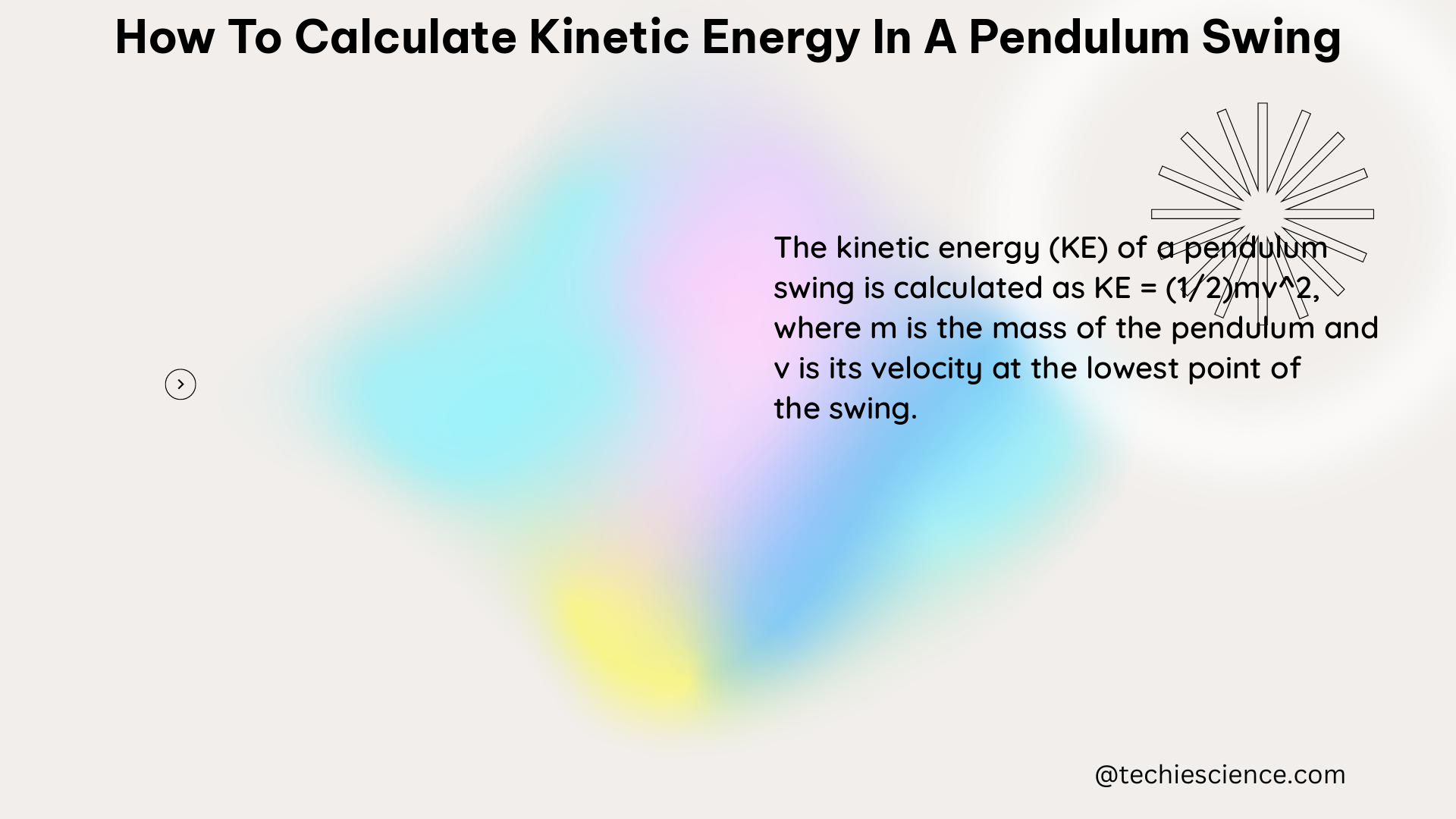Calculating the kinetic energy in a pendulum swing is a fundamental concept in classical mechanics. This comprehensive guide will provide you with a deep understanding of the physics behind pendulum motion and the step-by-step process to determine the kinetic energy at any point during the swing.
The Physics of Pendulum Motion
A pendulum consists of a mass (bob) suspended from a fixed point by a rod or string. When the pendulum is displaced from its equilibrium position and released, it begins to swing back and forth, transforming its energy between potential energy (PE) and kinetic energy (KE).
At the highest point of the swing, the pendulum has maximum potential energy and zero kinetic energy. As the pendulum moves towards the lowest point, the potential energy decreases, and the kinetic energy increases. At the bottom of the swing, the pendulum has maximum kinetic energy and zero potential energy.
The motion of a pendulum is governed by the following principles:
- Gravitational Force: The gravitational force acting on the pendulum bob provides the restoring force that causes the pendulum to swing back and forth.
- Centripetal Force: As the pendulum bob moves in a circular path, a centripetal force is required to keep it in that path. This centripetal force is provided by the tension in the string or rod.
- Conservation of Energy: The total energy of the pendulum (the sum of its potential energy and kinetic energy) remains constant throughout the swing, assuming no energy losses due to friction or air resistance.
Formulas for Kinetic Energy (KE) and Potential Energy (PE)

To calculate the kinetic energy in a pendulum swing, you need to understand the relevant formulas:
- Kinetic Energy (KE): The formula for kinetic energy is:
KE = 1/2 * m * v^2
where m is the mass of the pendulum bob, and v is its velocity.
- Potential Energy (PE): The formula for potential energy is:
PE = m * g * h
where m is the mass of the pendulum bob, g is the acceleration due to gravity, and h is the height of the pendulum bob above the reference level (usually the lowest point of the swing).
Calculating Kinetic Energy in a Pendulum Swing
To calculate the kinetic energy at any point during the pendulum’s swing, you need to determine the velocity (v) of the pendulum bob. You can calculate the velocity using the formula:
v = ω * L
where ω is the angular velocity of the pendulum, and L is the length of the pendulum.
The angular velocity (ω) can be calculated using the formula:
ω = dθ/dt
where dθ is the angular displacement (the angle by which the pendulum is displaced from its equilibrium position), and dt is the time taken for this displacement.
Once you have the velocity (v), you can calculate the kinetic energy (KE) using the formula:
KE = 1/2 * m * v^2
Example Calculation
Let’s consider a pendulum with the following parameters:
- Mass of the pendulum bob (
m): 0.1 kg - Length of the pendulum (
L): 0.5 m - Angular velocity of the pendulum (
ω): 2 rad/s
First, we calculate the velocity (v) of the pendulum bob:
v = ω * L = 2 * 0.5 = 1 m/s
Then, we calculate the kinetic energy (KE) of the pendulum:
KE = 1/2 * m * v^2 = 1/2 * 0.1 * 1^2 = 0.05 J
Therefore, the kinetic energy of the pendulum at this point is 0.05 Joules.
Advanced Considerations
- Pendulum Period: The period of a pendulum, which is the time it takes for the pendulum to complete one full swing, can be calculated using the formula:
T = 2π * √(L/g)
where T is the period, L is the length of the pendulum, and g is the acceleration due to gravity.
-
Small-Angle Approximation: For small-angle oscillations (where the angle of displacement is less than 15 degrees), the motion of the pendulum can be approximated as simple harmonic motion, and the formulas for kinetic and potential energy can be simplified.
-
Energy Dissipation: In real-world scenarios, energy dissipation due to factors like air resistance and friction can affect the pendulum’s motion and the calculation of kinetic energy. These effects can be incorporated into the analysis using more advanced techniques.
-
Compound Pendulum: A compound pendulum, which consists of a rigid body suspended from a fixed point, has a more complex energy transformation and requires additional considerations in the kinetic energy calculation.
-
Numerical Simulations: For more complex pendulum systems or to account for various factors, numerical simulations using computational tools can be employed to analyze the pendulum’s motion and energy dynamics.
Conclusion
Mastering the calculation of kinetic energy in a pendulum swing is a crucial step in understanding the fundamental principles of classical mechanics. By applying the formulas and concepts presented in this guide, you can confidently determine the kinetic energy at any point during the pendulum’s swing, laying the foundation for further exploration of pendulum dynamics and its applications in physics.
References
- Study.com: Potential & Kinetic Energy of a Pendulum | Overview & Examples
- Omnicalculator.com: Kinetic Energy of a Pendulum Calculator
- BU.edu: Energy in a Pendulum | Gary Garber’s Blog
- Teachengineering.org: Swinging Pendulum (for High School) – Activity
- Physicsclassroom.com: Physics Tutorial: Pendulum Motion

The lambdageeks.com Core SME Team is a group of experienced subject matter experts from diverse scientific and technical fields including Physics, Chemistry, Technology,Electronics & Electrical Engineering, Automotive, Mechanical Engineering. Our team collaborates to create high-quality, well-researched articles on a wide range of science and technology topics for the lambdageeks.com website.
All Our Senior SME are having more than 7 Years of experience in the respective fields . They are either Working Industry Professionals or assocaited With different Universities. Refer Our Authors Page to get to know About our Core SMEs.